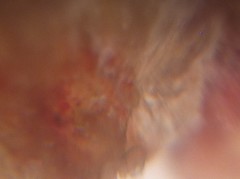Know your target, know your molecule
Mark E Bunnage, Adam M Gilbert,Lyn H Jones& Erik C Hett Nature Chemical Biology 11, 368–372 (2015) doi:10.1038/nchembio.1813 Published online 15 May 2015

- Bar color indicates the isoform type and bar size the percentage of the isoform present in the specified tissue. All isoforms annotated contain the catalytic domain. Long forms contain unique N-terminal regions as well as both the upstream conserved region 1 (UCR1) and UCR2 domains; the short form lacks UCR1; and the supershort form lacks UCR1 and has a truncated UCR2 domain. Data was obtained from GTEx (ref. 8) and analyzed at Pfizer. ACC, anterior cingulate cortex; sk muscle, skeletal muscle.
The pharmaceutical industry continues to experience significant attrition of drug candidates during phase 2 proof-of-concept clinical studies. We describe some questions about the characteristics of protein targets and small-molecule drugs that may be important to consider in drug-discovery projects and could improve prospects for future clinical success.
The issue of pharmaceutical R&D attrition has attracted significant interest in recent years. We have argued that the biggest opportunity to enhance overall R&D productivity is to focus on drug candidate survival through phase 2 and the selection of targets for which there is the highest confidence of relevance to human disease1, 2. We have also highlighted the role that chemical biology can play in preclinical target validation through generation of high-quality chemical probes3 and have described the following four ‘pillars’ as a framework for target validation using such probes:
- exposure at site of action;
- demonstration of target occupancy;
- proof of mechanistic pharmacology and
- the use of disease-relevant phenotypic assays2, 3.
This framework can also be used to assess whether a mechanism has been truly tested in the clinic, and establishing the first three of these pillars in human studies has been linked to clinical success4. In this Commentary we build on these themes and explore some key questions to consider regarding the characteristics of biomedical targets and the small molecules that modulate their function. We discuss why we believe the answers to these questions are important in drug discovery and highlight chemical biology techniques that can be used to help provide insight on the questions posed. It is our belief that such knowledge may help increase phase 2 success by aiding the identification of novel drug candidates that are more likely to deliver efficacy and safety in the clinic.
Over recent years, the application of chemical biology has become well embedded within drug discovery at Pfizer. As part of our broader chemical biology program, Pfizer has established a set of questions (Table 1) as a tool to help project teams fully consider the characteristics of their biological targets and small-molecule leads. These questions have also served as a framework for knowledge sharing across the company on how chemical biology approaches have been applied to advance projects in the portfolio. We highlight these questions in tabular form here in the hope that they can serve as a useful resource for others. In the discussion below, we explore a number of these questions in more detail and share some examples from the published literature of their relevance to drug discovery. However, it is important to stress that we are not proposing a set of rules or a checklist that should be addressed for all target-based drug-discovery programs. Instead, we hope that these questions can simply serve as a starting point for conversations within drug-discovery teams. Moreover, it is inevitable that there are many other questions associated with targets and molecular pharmacology that we have not considered here but could be similarly relevant to drug discovery. Alongside the publication of this article, we have thus included all the questions listed here (Table 1) and additional detail and references in the Chemical Biology Wikipedia page (http://en.wikipedia.org/wiki/Chemical_biology). We invite readers to add their contributions to this entry in the hope that it will develop into a useful resource for the chemical biology and drug-discovery community.
Reference
- Nat. Chem. Biol. 7, 335–339 (2011).
- et al. Nat. Rev. Drug Discov. 14, 149–150 (2015).
- , & Nat. Chem. Biol. 9, 195–199 (2013).
- et al. Drug Discov. Today 17, 419–424 (2012).
- et al. Nature 508, 222–227 (2014).
- et al. Mol. Cancer 13, 103 (2014).
- et al. J. Am. Chem. Soc. 135, 18153–18159 (2013).
- The Genotype-Tissue Expression (GTEx) project. Nat. Genet. 45, 580–585 (2013).
- , & Cell. Signal. 26, 657–663 (2014).
- et al. ACS Chem. Biol. 9, 1552–1558 (2014).
- , , , & Curr. Opin. Chem. Biol. 24, 48–57 (2015).
- & Chem. Rev. 113, 4633–4679 (2013).
- et al. Proc. Natl. Acad. Sci. USA 107, 13075–13080 (2010).
- et al. Cancer Res. 67, 7695–7702 (2007).
- et al. Nat. Chem. Biol. 9, 307–312 (2013).
- & Nature 487, 308–309 (2012).
- & Nature 513, 481–483 (2014).
- et al. Biochemistry 46, 350–358 (2007).
- et al. Nat. Chem. Biol. 10, 760–767 (2014).
- et al. Nat. Biotechnol. 29, 255–265 (2011).
- et al. Science 346, 1255784 (3 October 2014).
- et al. Science 327, 1345–1350 (2010).
- et al. Nat. Chem. Biol. 10, 768–773 (2014).
- et al. Proc. Natl. Acad. Sci. USA 111, 173–178 (2014).
- et al. Nature 464, 431–435 (2010).
- et al. J. Pharmacol. Exp. Ther. 338, 114–124 (2011).
- et al. ACS Chem. Biol. 10, 1094–1098 (2015).














Well Timothy you are claiming divine prayer and the authority of the power of God is the sole consolidator , at the same time you are aware that no need exist for molecules to aid you or Pedra or any proof of creation in biology for the authority of the power of God. All you need to do is pray which is obviously not helping because you are on-line with bed bugs pleading for federal income assistence for you and Pedra to move and get dope to smoke for you ailments.
Four molecules make up all life.
Proteins
Carbohydrates
Lipids
Nucleic acids
All of these molecules are no more than chemical compounds, the chemicals are universal and can be created in the universe like sugar molecules in stars, and these four are the ingredients to life and so on…
Before the solar system was born millions of different molecules existed in theb universe, from sugar, to carbohyrates, to………………….to, name it.
Even bed bugs came along.
LikeLike
It’s ok Rodney I am the expert my name is Timothy trespass I will make sure you have a safe entry to answer the question it’s called a subpoena Rodney which will bring you safely to the castle of the big house to answer the questions that you will have to answer even if your a postman still ridding your push bike around for a living it’s all good Rodney just tell the truth champ which ⌚️Will tell the good luck champ catch ya Rodney peace
LikeLike
MY IS RODNEY FROM AN ANONYMOUS LOCATION I AM SCARED THAT I AM GOING TO GO THROUGH THE SAME THING AS TIMOTHY TRESPAS BUT WORSE I DONT NO WHAT TO DO I CANT KEEP LIVING A LIE IN MY CAREER BECAUSE I WANNA BE THE GOOD GUY IN MY JOB WHICH I THOUGHT I COULD HANDLE UNTIL I GOT INVOVLED IN A SECRET DEPARTMENT THAT I CANT TALK ABOUT BECAUSE I AM SCARED TO GET LOCKED UP FOR MY CRIMES THAT I GOT INVOVLED IN ALL FOR MY STUPIDITY OF THINKING THAT I WAS UNTOUCHABLE UNTIL I CROSSED THE PATH OF ONE BLOKE THAT JUST WOULDNT CHOKE EVEN WHILE TALKING FOR DAYS AND YEARS ON SO PLEASE HELP ME SOMEONE EVEN YOU TIMOTHY TRESPASS HELP ME AND I WILL GET YOU A BLUE SHIRT AS A GIFT FROM MY WORK COLLEAGUES PLEASE HELP TIMOTHY TRESPASS I CANT ANSWER THE QUESTIONS I AM GONNA HAVE TO ANSWER HEY DO YOU THINK THAT I HAVE HAD BEEN MANIPULATED BY MY MASTERS BECAUSE AT THE END OF THE DAY I AM JUST A PUPPET WHICH A GLOCK AND WATCHING A CLOCK TICKING AND TICKING UNTIL THE JUDGMENT DAY HAS COME PLEASE TIMOTHY TRESPASS HELP ME HELP ME I DO WANT TO FORGET AND PLEASE FOR GIVE ME I FUCKED UP 🎡
LikeLike